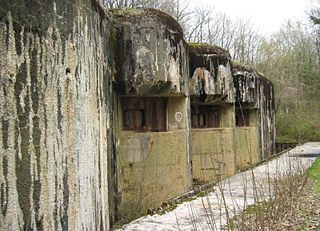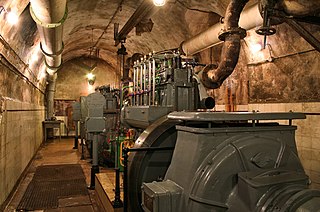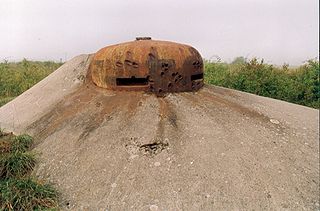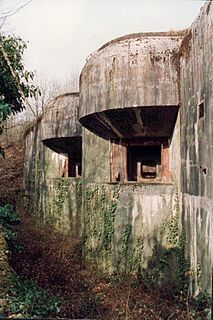
Ouvrage Latiremont is a gros ouvrage of the Maginot Line, located in the Fortified Sector of the Crusnes, sub-sector of Arrancy. It lies between the gros ouvrage Fermont and the petit ouvrage Mauvais Bois, facing Belgium. The village of Doncourt-Cités is nearby. Latiremont was active in 1939-1940, coming under direct attack in late June 1940. It surrendered to German forces on 27 June. After renovations during the Cold War, it was abandoned.

Ouvrage Mont des Welches, a gros ouvrage of the Maginot Line fortifications, is part of the Fortified Sector of Boulay. It comprises two entrance blocks, one infantry block, one artillery block, one observation block and two combination blocks. It is located between petit ouvrage Coucou and gros ouvrage Michelsberg, facing Germany. Relatively small for a gros ouvrage, Mont des Welches saw a brief period of sharp action in June 1940, when German forces moving along the rear of the Maginot Line engaged the position without success. After modest renovations in the 1950s, Mont des Welches was abandoned in the 1970s.

Ouvrage Michelsberg, one of the Maginot Line fortifications, formed part of the Fortified Sector of Boulay as well as the fortified region of Metz. The ouvrage is located in Moselle (département) between the towns of Dalstein and d'Ebersviller, about 23 km from Thionville. It is located between gros ouvrage Mont des Welches and petit ouvrage Hobling, facing Germany. Michelsberg did not see significant action in the Battle of France until June 1940, when it was attacked from the rear by German forces that had bypassed the Maginot Line. It successfully resisted these attacks, but was compelled to surrender in accordance with the 25 June 1940 armistice. After the Second World War it was renovated as a Cold War fortification against a potential Soviet invasion, then abandoned. It is now operated as a museum, and may be visited.

Ouvrage Laudrefang is a lesser work of the Maginot Line. Located in the Fortified Sector of Faulquemont, the ouvrage consists of one infantry block, and is located between petits ouvrages Einseling and Teting, facing Germany. Laudrefang was originally planned as a gros ouvrage. With a heavy armament for a petit ouvrage it successfully defended its neighbors against German attack during the Battle of France. Laudrefang is abandoned and flooded, and was heavily damaged by German bombardment in 1940.

Ouvrage Billig, a gros ouvrage or large fortification of the Maginot Line, was located in the Fortified Sector of Thionville, Moselle in northern France. It is located between the gros ouvrages Metrich and Hackenberg, facing Germany. It saw relatively little action during World War II and after a period of reserve duty in the 1950s, was abandoned in the 1970s.

Ouvrage Fermont is a gros ouvrage of the Maginot Line, part of the Fortified Sector of the Crusnes in northeastern France, near the community of Montigny-sur-Chiers. It is located near the commune of Montigny-sur-Chiers, between the petit ouvrage Ferme Chappy and the gros ouvrage Latiremont. The position is near the western end of the Line, about four kilometers east of Longuyon, facing Belgium. There was significant combat at Fermont during the last stages of the Battle of France. It was repaired and reactivated during the 1950s and 1960s as a strongpoint in the event of an invasion by Soviet forces. After being abandoned by the military, it has been restored and is maintained as a museum.

Ouvrage Aumetz is a small work, or petit ouvrage of the Maginot Line. It is part of the Fortified Sector of the Crusnes and is located near the community of Aumetz in the Moselle département of France. The petit ouvrage flanked by the gros ouvrages Bréhain and Rochonvillers, all facing the France-Luxembourg border. Aumetz was initially planned as a gros ouvrage of six combat blocks, but only three infantry blocks were built. Aumetz saw limited action during the Battle of France. In the 1970s it was the first Maginot position to be offered for sale to the public.

Ouvrage Saint Ours Haut is a work of the Maginot Line's Alpine extension, the Alpine Line, also known as the Little Maginot Line. The ouvrage consists of one infantry block, one artillery block, two observation blocks and one combination block in the vicinity of the Col de Larche. It is located on the territory of the commune of Meyronnes. Construction began in March 1931, at a cost of 15.1 million francs.

Ouvrage Restefond is a work of the Maginot Line's Alpine extension, the Alpine Line. The ouvrage consists of one artillery block and three observation blocks at the summit of the Col de la Bonnette. The entry block and an artillery block were not completed, and a further block was never built. At 2,733 metres (8,967 ft), Restefond is the highest Maginot ouvrage.

Ouvrage Gordolon is a work of the Maginot Line's Alpine extension, the Alpine Line, also known as the Little Maginot Line. The ouvrage consists of one and two infantry blocks at an altitude of 728 metres (2,388 ft). Gordolon was built by Borie contractors at a cost of 21.4 million francs. Work started in November 1931 and was completed in April 1934.

Ouvrage Flaut is a work of the Maginot Line's Alpine extension, the Alpine Line, also called the Little Maginot Line. The ouvrage consists of one entry block, one infantry block and one artillery block at an altitude of 771 metres (2,530 ft). The position was intended, acting with Ouvrage Gordolon, to stop an approach by Italian forces from the north towards Nice through the Vésibie Valley.

Ouvrage Plan Caval is a lesser work of the Maginot Line's Alpine extension, the Alpine Line, also known as the Little Maginot Line. The ouvrage consists of two infantry blocks and one observation block facing Italy. The ouvrage is located on the heights of L'Authion, surrounded by older fortifications. Three additional blocks were planned to make it a gros ouvrage but were not built. Cost for the full ensemble was estimated at 23 million francs.

Ouvrage Col de Brouis is a work of the Maginot Line's Alpine extension, the Alpine Line, also known as the Little Maginot Line. The ouvrage consists of one entry block and two artillery blocks facing Italy at an altitude of 871 metres (2,858 ft). The ouvrage is located about one kilometer north of Monte Grosso. It was placed to control the Col de Brouis and the D 2204 road between the Breil and Sospel.

Ouvrage Monte Grosso is a work of the Maginot Line's Alpine extension, the Alpine Line, also known as the Little Maginot Line. The ouvrage consists of one entry block, four artillery blocks and two observation blocks facing Italy. It was the largest ouvrage in the Alps It is part of the fortifications surrounding Sospel, which protect the approaches to Nice from the north.

Ouvrage L'Agaisen is a work of the Maginot Line's Alpine extension, the Alpine Line, also known as the Little Maginot Line. The ouvrage consists of one entry block, two artillery blocks and one observation block above Sospel. Additional blocks were planned but not built. The ouvrage is located at an altitude of 663 metres (2,175 ft) on the Agaisen massif overlooking Sospel from the north. The position fired 1821 shots from Block 3's 75mm gun turret in 1940. It has an unusual 75mm gun turret in Block 3.

Ouvrage Saint-Roch is a work of the Maginot Line's Alpine extension, the Alpine Line, also known as the Little Maginot Line. Small for a gros ouvrages, the ouvrage consists of one entry block, one artillery block and two observation blocks overlooking Sospel at an altitude of 426 metres (1,398 ft). The position is located just to the southwest of Sospel, its entrance block in a narrow valley and the artillery block on the other side of the ridge overlooking Sospel. The ouvrage is laid out along a single line, with the entry block to the rear, immediately followed by the usine, with barracks farther along and Blocks 2 and 3 at intervals. The position's main armament is concentrated in Block 4, a massive blockhouse designed to protect against rockfalls from higher up the mountain.

Ouvrage Castillon is a work of the Maginot Line's Alpine extension, the Alpine Line, also called the Little Maginot Line. The ouvrage consists of one entry block, two infantry blocks, and two artillery blocks in a narrow ridge just to the west of Castillon, Alpes-Maritimes. It was built on the original site of Castillon, destroyed by an earthquake in 1887. It is the next gros ouvrage in the line to the north of Ouvrage Sainte-Agnès, and is within firing range of the Mediterranean coastline.

Ouvrage Mont Agel is a work of the Maginot Line's Alpine extension, the Alpine Line, also called the Little Maginot Line. The 1930s ouvrage was built in and around the earlier mountaintop Fortress of Mont Agel. The ouvrage forms a backup to the main curtain of Alpine Line forts, and was not initially planned as part of the Alpine Line proper. Its intended function was primarily to provide heavy, long-range artillery support from a location well to the rear of the line. However, the planned 145mm heavy guns were never installed. Its site on Mont Agel, at an altitude of 1,118 metres (3,668 ft), is the highest point in the vicinity of Nice and Menton and commands the entire coastline, as well as the approaches from Sospel to the north. The site is now occupied by Base Aérienne 943 of the French Air Force and functions as an air defense control station.

Ouvrage Cap Martin is a work of the Maginot Line's Alpine extension, the Alpine Line, also called the Little Maginot Line. The ouvrage, located on high ground in Roquebrune, consists of two artillery blocks and one combination block facing Italy. The ouvrage was at the southernmost end of the Alpine Line and overlooked the Mediterranean Sea coastline at an altitude of 21 meters between Nice and Menton, facing towards Italy. The ouvrage and its advance casemate at Pont Saint Louis controlled the coastal roads along the Mediterranean.

Ouvrage Sainte-Agnès was a work of the Maginot Line's Alpine extension, the Alpine Line, also called the Little Maginot Line. The fortification was built between 1932 and 1938. The site is at the south edge of the hill town of Sainte-Agnès, Alpes-Maritimes at an elevation of 780 metres overlooking the Mediterranean Sea.














